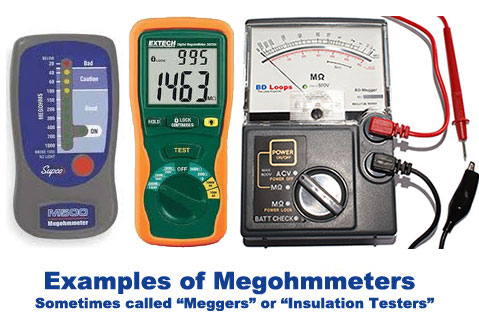Help & Instructions
How to Properly Meg a Loop
Did you know BD Loops sells a megohmmeter? Click here to find out more?
Warning: I wanted to start this guide off with a friendly warning, while the megohmmeter is turned on you will want to make sure you never touch both metal leads from the megohmmeter at the same time, you will get shocked.
Step 1: Do you have a Megohmmeter or a Multimeter?
To properly “meg” a loop you must use a megohmmeter and not a multimeter. Because multimeters have an “ohm” setting many installers falsely believe that a multimeter can be used to “meg a loop”. Here is a quick look at how megohmmeters and multimeters differ:
Multimeters generally measure Continuity, Resistance, and Voltage. (For loops multimeters will check continuity, but will not tell you if the loop is shorting to ground.)
Megohmmeters are Insulation Testers. (Megohmmeters will tell you if the loop wire’s insulation has been nicked as is causing a short to ground.)

Step 2: Okay I have a Megohmmeter, now what?
Fantastic! Here are step by step instructions on how to test a loop using a megohmmeter. What you really want to look out for here is making sure that you’re attaching one of the megohmmeter’s clip to an earth ground (such as an operator chassis) and the other clip to one of the loop’s lead-in wires.
Step 1: Remove both of the loop lead-in wires from the operator or detector.
Step 2: Attach one of the megohmmeter’s clips (if your megohmmeter has clips) to an earth ground such as the operator frame or a 12″ screwdriver driven into the ground. (You can pour water on the screwdriver to help ground the connection.)
Step 3: If the device has switches on it, make sure it is set to the MΩ position.
Step 4: Touch the other clip or lead from the megohmmeter to one of the loop lead-ins (it doesn’t matter which lead-in wire you use).
Step 5: Read the Meter.
If you are using an analog meter look at the needle’s position:
Below 10 MΩ – Bad Loop (This Loop will need to be replaced)
10-20 MΩ – Suspect or Questionable Loop (we highly recommend that you replace the loop)
45-2000 MΩ – Good Loop
Step 6: Water down the area of the loop and lead-in and then take another reading. Loops often require water in the groove to facilitate a short to ground, and will read as a good loop in dry conditions. Is your reading significantly lower with water in the groove?
If you are using a digital meter: (They are a bit more difficult to read)
You will likely have to read the instructions that came with your meter to make sure you are interpreting the results correctly. Some digital meters give number readings similar to the analog meters, and in that case use the chart above. Some meters have lights that will tell you if the loop is good, questionable, or bad.
In Summary:
It is important to remember that only one of the megohmmeters clip leads will be connected to the loop, the other must be connected to ground.
We know that it is not very intuitive since you have 2 clip leads from the megohmeter and 2 lead-in wires on the loop, many installers will clip both leads to the loop. If an installer does connect both clip leads to the loop the megohmmeter will incorrectly show that the loop is bad or failing. (Go ahead and test it yourself, It won’t damage the loop.)
We want to prevent installers from accidentally replacing good loops by making such a small mistake while testing.
If you need additional assistance with using a megohmmeter or testing loops in general please give us a call: 714-890-1604
BD Loops
The Loop Experts!
BD Loops was founded in 2001. Their preformed loops and accessories are designed with the installer in mind. BD Loops offers a complete loop system solution including preformed direct burial loops, preformed saw-cut loops, loop sealant, blades, testing devices, and installation tools. BD Loops has a reputation for reliability and ease of installation. They pride themselves on the quality of their products and their commitment to providing excellent customer service and support. BD Loops preformed loops are made in the USA at their facility in Placentia, CA.

